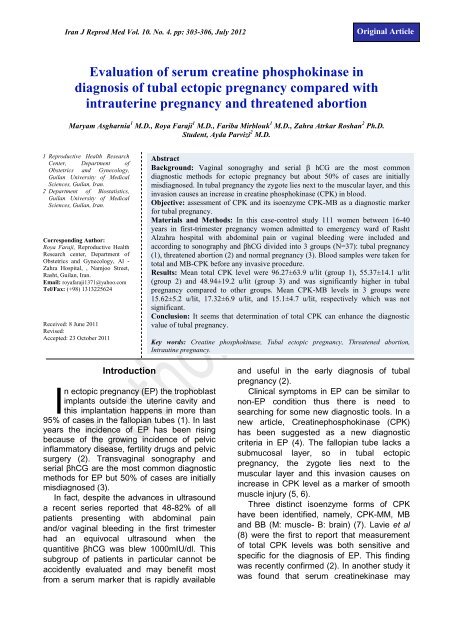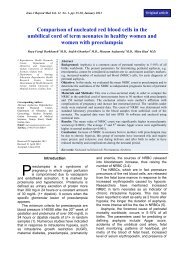Evaluation of serum creatine phosphokinase in diagnosis of tubal ...
Evaluation of serum creatine phosphokinase in diagnosis of tubal ...
Evaluation of serum creatine phosphokinase in diagnosis of tubal ...
Create successful ePaper yourself
Turn your PDF publications into a flip-book with our unique Google optimized e-Paper software.
Iran J Reprod Med Vol. 10. No. 4. pp: 303-306, July 2012<br />
Orig<strong>in</strong>al Article<br />
<strong>Evaluation</strong> <strong>of</strong> <strong>serum</strong> <strong>creat<strong>in</strong>e</strong> <strong>phosphok<strong>in</strong>ase</strong> <strong>in</strong><br />
<strong>diagnosis</strong> <strong>of</strong> <strong>tubal</strong> ectopic pregnancy compared with<br />
<strong>in</strong>trauter<strong>in</strong>e pregnancy and threatened abortion<br />
Maryam Asgharnia 1 M.D., Roya Faraji 1 M.D., Fariba Mirblouk 1 M.D., Zahra Atrkar Roshan 2 Ph.D.<br />
Student, Ayda Parvizi 2 M.D.<br />
1 Reproductive Health Research<br />
Center, Department <strong>of</strong><br />
Obstetrics and Gynecology,<br />
Guilan University <strong>of</strong> Medical<br />
Sciences, Guilan, Iran.<br />
2 Department <strong>of</strong> Biostatistics,<br />
Guilan University <strong>of</strong> Medical<br />
Sciences, Guilan, Iran.<br />
Correspond<strong>in</strong>g Author:<br />
Roya Faraji, Reproductive Health<br />
Research center, Department <strong>of</strong><br />
Obstetrics and Gynecology, Al -<br />
Zahra Hospital, , Namjoo Street,<br />
Rasht, Guilan, Iran.<br />
Email: royafaraji1371@yahoo.com<br />
Tel/Fax: (+98) 1313225624<br />
Received: 8 June 2011<br />
Revised:<br />
Accepted: 23 October 2011<br />
Abstract<br />
Background: Vag<strong>in</strong>al sonograghy and serial hCG are the most common<br />
diagnostic methods for ectopic pregnancy but about 50% <strong>of</strong> cases are <strong>in</strong>itially<br />
misdiagnosed. In <strong>tubal</strong> pregnancy the zygote lies next to the muscular layer, and this<br />
<strong>in</strong>vasion causes an <strong>in</strong>crease <strong>in</strong> <strong>creat<strong>in</strong>e</strong> <strong>phosphok<strong>in</strong>ase</strong> (CPK) <strong>in</strong> blood.<br />
Objective: assessment <strong>of</strong> CPK and its isoenzyme CPK-MB as a diagnostic marker<br />
for <strong>tubal</strong> pregnancy.<br />
Materials and Methods: In this case-control study 111 women between 16-40<br />
years <strong>in</strong> first-trimester pregnancy women admitted to emergency ward <strong>of</strong> Rasht<br />
Alzahra hospital with abdom<strong>in</strong>al pa<strong>in</strong> or vag<strong>in</strong>al bleed<strong>in</strong>g were <strong>in</strong>cluded and<br />
accord<strong>in</strong>g to sonography and βhCG divided <strong>in</strong>to 3 groups (N=37): <strong>tubal</strong> pregnancy<br />
(1), threatened abortion (2) and normal pregnancy (3). Blood samples were taken for<br />
total and MB-CPK before any <strong>in</strong>vasive procedure.<br />
Results: Mean total CPK level were 96.27±63.9 u/lit (group 1), 55.37±14.1 u/lit<br />
(group 2) and 48.94±19.2 u/lit (group 3) and was significantly higher <strong>in</strong> <strong>tubal</strong><br />
pregnancy compared to other groups. Mean CPK-MB levels <strong>in</strong> 3 groups were<br />
15.62±5.2 u/lit, 17.32±6.9 u/lit, and 15.1±4.7 u/lit, respectively which was not<br />
significant.<br />
Conclusion: It seems that determ<strong>in</strong>ation <strong>of</strong> total CPK can enhance the diagnostic<br />
value <strong>of</strong> <strong>tubal</strong> pregnancy.<br />
Key words: Creat<strong>in</strong>e <strong>phosphok<strong>in</strong>ase</strong>, Tubal ectopic pregnancy, Threatened abortion,<br />
Intraut<strong>in</strong>e pregnancy.<br />
Introduction<br />
I<br />
n ectopic pregnancy (EP) the trophoblast<br />
implants outside the uter<strong>in</strong>e cavity and<br />
this implantation happens <strong>in</strong> more than<br />
95% <strong>of</strong> cases <strong>in</strong> the fallopian tubes (1). In last<br />
years the <strong>in</strong>cidence <strong>of</strong> EP has been ris<strong>in</strong>g<br />
because <strong>of</strong> the grow<strong>in</strong>g <strong>in</strong>cidence <strong>of</strong> pelvic<br />
<strong>in</strong>flammatory disease, fertility drugs and pelvic<br />
surgery (2). Transvag<strong>in</strong>al sonography and<br />
serial βhCG are the most common diagnostic<br />
methods for EP but 50% <strong>of</strong> cases are <strong>in</strong>itially<br />
misdiagnosed (3).<br />
In fact, despite the advances <strong>in</strong> ultrasound<br />
a recent series reported that 48-82% <strong>of</strong> all<br />
patients present<strong>in</strong>g with abdom<strong>in</strong>al pa<strong>in</strong><br />
and/or vag<strong>in</strong>al bleed<strong>in</strong>g <strong>in</strong> the first trimester<br />
had an equivocal ultrasound when the<br />
quantitive βhCG was blew 1000mIU/dl. This<br />
subgroup <strong>of</strong> patients <strong>in</strong> particular cannot be<br />
accidently evaluated and may benefit most<br />
from a <strong>serum</strong> marker that is rapidly available<br />
and useful <strong>in</strong> the early <strong>diagnosis</strong> <strong>of</strong> <strong>tubal</strong><br />
pregnancy (2).<br />
Cl<strong>in</strong>ical symptoms <strong>in</strong> EP can be similar to<br />
non-EP condition thus there is need to<br />
search<strong>in</strong>g for some new diagnostic tools. In a<br />
new article, Creat<strong>in</strong>e<strong>phosphok<strong>in</strong>ase</strong> (CPK)<br />
has been suggested as a new diagnostic<br />
criteria <strong>in</strong> EP (4). The fallopian tube lacks a<br />
submucosal layer, so <strong>in</strong> <strong>tubal</strong> ectopic<br />
pregnancy, the zygote lies next to the<br />
muscular layer and this <strong>in</strong>vasion causes on<br />
<strong>in</strong>crease <strong>in</strong> CPK level as a marker <strong>of</strong> smooth<br />
muscle <strong>in</strong>jury (5, 6).<br />
Three dist<strong>in</strong>ct isoenzyme forms <strong>of</strong> CPK<br />
have been identified, namely, CPK-MM, MB<br />
and BB (M: muscle- B: bra<strong>in</strong>) (7). Lavie et al<br />
(8) were the first to report that measurement<br />
<strong>of</strong> total CPK levels was both sensitive and<br />
specific for the <strong>diagnosis</strong> <strong>of</strong> EP. This f<strong>in</strong>d<strong>in</strong>g<br />
was recently confirmed (2). In another study it<br />
was found that <strong>serum</strong> <strong>creat<strong>in</strong>e</strong>k<strong>in</strong>ase may
Asgharnia et al<br />
help <strong>in</strong> discrim<strong>in</strong>at<strong>in</strong>g ruptured from ruptured<br />
EP, whereas it is not useful for the primary<br />
<strong>diagnosis</strong> <strong>of</strong> ectopic gestation (9). Others<br />
have shown that, although women with EP<br />
tend to have higher CPK levels, a significant<br />
overlap <strong>of</strong> values, limits the diagnostic value<br />
<strong>of</strong> CPK measurements (10-14).<br />
Also <strong>in</strong> one recent study the researcher<br />
suggested CPK is an <strong>in</strong>dicator for predict<strong>in</strong>g<br />
treatment outcome. In their study CPK level<br />
was significantly higher <strong>in</strong> women who<br />
successfully treated for Ectopic pregnancy<br />
with only a s<strong>in</strong>gle <strong>in</strong>jection <strong>of</strong> methotrexate<br />
(15). It must be mentioned that <strong>in</strong> most <strong>of</strong><br />
previous studies total CPK levels were<br />
measured except for one (7) <strong>in</strong> which CPK<br />
MM and MB levels estimated and found that<br />
women with EP had significantly higher CPK<br />
and significantly lower CPK-MB relative ratio.<br />
Accord<strong>in</strong>g to controversial results <strong>of</strong><br />
previous studies the current study was<br />
designed to further evaluation the diagnostic<br />
value <strong>of</strong> total CPK <strong>in</strong> ectopic pregnancy and to<br />
evaluate the possible discrim<strong>in</strong>atory ability <strong>of</strong><br />
its isoenzymes; because <strong>in</strong> Iran, we measure<br />
CPK-total and CPK_MB. (CPK MM can’t be<br />
measured <strong>in</strong> Iran)<br />
Materials and methods<br />
In this case-control study 111 (range 16-40<br />
years) first-trimester pregnant women<br />
admitted to emergency ward <strong>of</strong> Rasht Alzahra<br />
Hospital with lower abdom<strong>in</strong>al pa<strong>in</strong> and/or<br />
vag<strong>in</strong>al bleed<strong>in</strong>g were <strong>in</strong>cluded (from Sep.<br />
2009 to Feb. 2010).<br />
Accord<strong>in</strong>g to vag<strong>in</strong>al Ultrasonography and<br />
serial βhCG, patients divided <strong>in</strong>to 3 groups<br />
with f<strong>in</strong>al <strong>diagnosis</strong>, each group consisted <strong>of</strong><br />
37 patients: 1) <strong>tubal</strong> ectopic pregnancy 2)<br />
Threatened abortion 3) normal <strong>in</strong>tra-uter<strong>in</strong>e<br />
pregnancy (Nl IUP). Patients followed up<br />
longitud<strong>in</strong>ally to establish the <strong>diagnosis</strong>.<br />
To limit confound<strong>in</strong>g factors, we identified<br />
and excluded patients with a recent history <strong>of</strong><br />
surgery, major truma, chest pa<strong>in</strong>, CNS<br />
disorders, hypothyrodism, myopathy or<br />
<strong>in</strong>tramuscular <strong>in</strong>jection. Blood samples were<br />
taken by rout<strong>in</strong>e ver<strong>in</strong>pucture (for total and MB<br />
CPK) before any <strong>in</strong>vasive procedure. Total<br />
and MB CPK were measured by photometric<br />
pars-azmun kit at 37 o C the upper reference <strong>of</strong><br />
total CPK for women was 170 U/Lit at 37 o C.<br />
This study was done with f<strong>in</strong>ancial support <strong>of</strong><br />
Vice chancellor <strong>of</strong> research Guilan University<br />
<strong>of</strong> Medical Sciences.<br />
Statistical analysis<br />
Data gathered <strong>in</strong> special checklists and<br />
f<strong>in</strong>ally analyzed with SPSS s<strong>of</strong>tware. The<br />
categorical outcome variables compared with<br />
One Way ANOVA test. The statistical<br />
significance was set at 0.05 levels.<br />
Results<br />
In cases the mean <strong>of</strong> age was 27.6±5.8<br />
(range 16-40 years) most <strong>of</strong> them were <strong>in</strong> age<br />
group <strong>of</strong> 25-29 (34.2%). We had 111 cases <strong>in</strong><br />
3 groups; each group consisted <strong>of</strong> 37 patients.<br />
From 37 patients <strong>in</strong> EP group, one case had<br />
fetal heart rate <strong>in</strong> sonograghy. We had 5<br />
cases <strong>of</strong> ruptured EP <strong>in</strong> this group. Most <strong>of</strong> EP<br />
patients received Methotraxate therapy [26<br />
patients <strong>of</strong> EP groups-(70.2%)], 4 patients<br />
(10.8%) managed by laparoscopy and for 7<br />
(19%) <strong>of</strong> them laparatomy was performed.<br />
The mean <strong>of</strong> total CPK are shown <strong>in</strong> figure1.<br />
Which was 96.27±63.9 u/lit for EP, 55.37±14.1<br />
u/lit for threatened abortion and 48.94±19.2<br />
for <strong>in</strong>taur<strong>in</strong>e pregnancy.<br />
In one way ANOVA test the mean level <strong>of</strong><br />
total CPK was significantly higher <strong>in</strong> <strong>tubal</strong><br />
pregnancy compared to other groups (pvalue
Table I. The mean level <strong>of</strong> CPK-MB <strong>in</strong> three groups.<br />
Groups (n=37) level <strong>of</strong> CPK-MB m<strong>in</strong> max p-value<br />
Ectopic pregnancy (Mean±SD) 15.62±5.2 5 30<br />
Threatened abortion(Mean±SD) 17.32±6.9 8 33<br />
NL IUP(Mean±SD) 15.1±4.7 6 26<br />
0.219 (NS)<br />
Table II. The mean level <strong>of</strong> total CPK after omitt<strong>in</strong>g ruptured EP.<br />
Groups(n=37) total CPK after omitt<strong>in</strong>g ruptured EP m<strong>in</strong> max p-value<br />
Unruptured ectopic pregnancy (n=32) (Mean±SD) 86.40±51.6 34 330<br />
Threatened abortion(±SD) 55.37±14.1 35 92<br />
NL IUP(±SD) 48.94±19.2 20 85<br />
0.0001<br />
Figure 1. The mean level <strong>of</strong> total CPK <strong>in</strong> three groups.<br />
Discussion<br />
Ectopic pregnancy is a relatively common<br />
complication, which can be fatal, if not<br />
promptly diagnosed. Threatened abortion is<br />
another, more benign cause <strong>of</strong> abdom<strong>in</strong>al<br />
pa<strong>in</strong>, which must be dist<strong>in</strong>guished from EP.<br />
Therefore it is important to have reliable<br />
predictors <strong>in</strong> the differential <strong>diagnosis</strong> <strong>of</strong> these<br />
two conditions (7).<br />
In the current study, total CPK levels were<br />
significantly <strong>in</strong>creased <strong>in</strong> women with EP<br />
compared with both women with miscarriage<br />
and those with normal gestation (Table I). This<br />
difference, <strong>in</strong> accordance with the result <strong>of</strong><br />
previous studies (6-9) was expected, because<br />
fetal <strong>in</strong>vasion <strong>in</strong>to the <strong>tubal</strong> smooth muscle<br />
layer results <strong>in</strong> tissue <strong>in</strong>jury, which has been<br />
known to raise the concentration <strong>of</strong> <strong>serum</strong><br />
CPK. In Soundravally study CPK level was<br />
higher <strong>in</strong> isthmica <strong>tubal</strong> pregnancies and<br />
ruptured ectopic pregnancies.<br />
It is likely that as <strong>tubal</strong> pregnancies grows<br />
and progresses towards rupture, then <strong>serum</strong><br />
CPK concentrations are <strong>in</strong>creased thus they<br />
concluded this hasn’t proven to be a cl<strong>in</strong>ically<br />
useful discrim<strong>in</strong>ator (1). Katsikis et al (7)<br />
studied 40 women with EP, 20 with IUP and<br />
20 with abortive gestation and measured total<br />
CPK, CPK MM and CPK MB at the time <strong>of</strong><br />
presentation and 24 hours after surgery and<br />
showed that women with EP had significantly<br />
higher total CPK and a significantly decreased<br />
CPK-MB relative ratio compared with other<br />
groups.<br />
In our study we couldn’t f<strong>in</strong>d any significant<br />
difference <strong>in</strong> CPK-MB level <strong>in</strong> 3 groups. Saha<br />
et al (16) studied 20 women with EP and 20<br />
women with NL pregnancy <strong>in</strong> a case-control<br />
study. Total CPK level were found to be<br />
significantly higher <strong>in</strong> EP group (34.15±1.17<br />
U/L) compared to the controls (18.72±1.25),<br />
which was <strong>in</strong> accordance <strong>of</strong> our study. Lavie<br />
et al (8) enrolled 3 groups <strong>of</strong> 17 patients for<br />
EP, abortion and NL IUP. CPK level was >45<br />
U/Lit <strong>in</strong> all patients with <strong>tubal</strong> pregnancy,<br />
significantly higher than the level <strong>in</strong> patients <strong>of</strong><br />
other groups. Birkhahan (2), Duncan (10),<br />
Kurzel (17) and Chandra (18) reported the<br />
same results. But on the other hand we have<br />
some articles which refused these results.<br />
Vitoratos et al (5) selected 10 patients with<br />
Iranian Journal <strong>of</strong> Reproductive Medic<strong>in</strong>e Vol. 10. No. 4. pp: 303-306, July 2012 305
asymptotic <strong>tubal</strong> pregnancy 11 with<br />
symptomatic <strong>tubal</strong> pregnancy, 20 with NL IUP<br />
and 15 with threatened abortion. No<br />
significant difference <strong>of</strong> total CPK levels was<br />
observed between groups.<br />
Birkhan et al (6) assessed 278 patients<br />
(61with EP-317 with non-Ep) and reported<br />
that <strong>serum</strong> Creat<strong>in</strong>e Phoshok<strong>in</strong>ase, smooth<br />
muscle heavy-cha<strong>in</strong> myos<strong>in</strong> and myoglub<strong>in</strong><br />
cannot be useful marker for EP. Korhonen<br />
(11) and Vandermolen (12) reported the same<br />
issues. Develioglu found that they had<br />
significant difference <strong>in</strong> the level <strong>of</strong> CPK<br />
between ampullary and isthmic position <strong>of</strong><br />
ectopic pregnancy thus this variable may have<br />
affected their results (9). The difference<br />
between studies can be because <strong>of</strong> different<br />
gestational ages. Gestational location <strong>of</strong> EP<br />
and the degree <strong>of</strong> <strong>tubal</strong> distention can be<br />
another reason but Kurzel reported that these<br />
two items won’t affect the CPK level.<br />
One possible explanation is that the <strong>serum</strong><br />
biomarkers <strong>of</strong>ten don’t follow a steady pattern<br />
over a normal gestation, also all subjects must<br />
matched for gestational age because if the<br />
subject didn’t be matched for gestational age<br />
large differences could be seen with<strong>in</strong> the<br />
same group another explanation differ<strong>in</strong>g<br />
results may be due to artifact <strong>of</strong> different<br />
methods for identifications and the reagent<br />
use to detect them (19). All patients <strong>in</strong> our<br />
study were admitted <strong>in</strong> hospital but the results<br />
may differ <strong>in</strong> patients admitted or patients who<br />
are not. In our study the correlation between<br />
βhCG and total CPK analyzed which was<br />
never done before. We can say determ<strong>in</strong>ation<br />
<strong>of</strong> total CPK <strong>in</strong> comb<strong>in</strong>ation with TVS and<br />
serial βhCG can enhance the diagnostic value<br />
<strong>of</strong> Ectopic <strong>tubal</strong> pregnancy.<br />
Conclusion<br />
Large-scale prospective studies are<br />
needed for better evaluation and to determ<strong>in</strong>e<br />
a cut-<strong>of</strong>f po<strong>in</strong>t for CPK.<br />
References<br />
1. Soundravally R, Soundara Raghavan S, Selvaraj N.<br />
Serum <strong>creat<strong>in</strong>e</strong> k<strong>in</strong>ase as a predictor <strong>of</strong> <strong>tubal</strong> ectopic<br />
pregnancy. Int J Gynaecol Obstet 2007; 98: 253-254.<br />
2. Birkhahn RH, Gaeta TJ, Leo PJ, Bove JJ. The utility<br />
<strong>of</strong> maternal <strong>creat<strong>in</strong>e</strong> k<strong>in</strong>ase <strong>in</strong> the evaluation <strong>of</strong><br />
ectopic pregnancy. Am J Emerg Med 2000; 18: 695-<br />
697.<br />
3. Cabar FR, Fettback PB, Pereira PP, Zugaib M.<br />
Serum markers <strong>in</strong> the <strong>diagnosis</strong> <strong>of</strong> <strong>tubal</strong> pregnancy.<br />
Cl<strong>in</strong>ics (Sao Paulo) 2008; 63: 701-708.<br />
4. Segal S, Mercado R, Rivnay B. Ectopic pregnancy<br />
early <strong>diagnosis</strong> markers. M<strong>in</strong>erva G<strong>in</strong>ecol 2010; 62:<br />
49-62.<br />
5. Vitoratos N, Gregoriou O, Papadias C, Konidaris S,<br />
Kalogirou D, Kalampokis D, et al. Cl<strong>in</strong>ical value <strong>of</strong><br />
creat<strong>in</strong><strong>in</strong>e k<strong>in</strong>ase <strong>in</strong> the <strong>diagnosis</strong> <strong>of</strong> ectopic<br />
pregnancy. Gynecol Obstet Invest 1998; 46: 80-83.<br />
6. Birkhahn RH, Gaeta TJ, Paraschiv D, Bove JJ,<br />
Suzuki T, Katoh H, et al. Serum levels <strong>of</strong> myoglob<strong>in</strong>,<br />
<strong>creat<strong>in</strong>e</strong> <strong>phosphok<strong>in</strong>ase</strong>, and smooth muscle heavycha<strong>in</strong><br />
myos<strong>in</strong> <strong>in</strong> patients with ectopic pregnancy. Ann<br />
Emerg Med 2001; 38: 628-632.<br />
7. Katsikis I, Rousso D, Farmakiotis D, Kourtis A,<br />
Diamanti-Kandarakis E, Zournatzi-Koiou V, et al.<br />
Creat<strong>in</strong>e <strong>phosphok<strong>in</strong>ase</strong> <strong>in</strong> ectopic pregnancy<br />
revisited: significant diagnostic value <strong>of</strong> its MB and<br />
MM isoenzyme fractions. Am J Obstet Gynecol 2006;<br />
194: 86-91.<br />
8. Lavie O, Beller U, Neuman M, Ben-Chetrit A,<br />
Gottcshalk-Sabag S, Diamant YZ. Maternal <strong>serum</strong><br />
<strong>creat<strong>in</strong>e</strong> k<strong>in</strong>ase: a possible predictor <strong>of</strong> <strong>tubal</strong><br />
pregnancy. Am J Obstet Gynecol 1993; 169: 1149-<br />
1150.<br />
9. Develioglu OH, Askalli C, Uncu G, Samli B,<br />
Daragenli O. <strong>Evaluation</strong> <strong>of</strong> <strong>serum</strong> <strong>creat<strong>in</strong>e</strong> k<strong>in</strong>ase <strong>in</strong><br />
ectopic pregnancy with reference to <strong>tubal</strong> status and<br />
histopathology. BJOG 2002; 109: 121-128.<br />
10. Duncan WC, Sweet<strong>in</strong>g VM, Cawood P, Ill<strong>in</strong>gworth<br />
PJ. Measurement <strong>of</strong> <strong>creat<strong>in</strong>e</strong> k<strong>in</strong>ase activity and<br />
<strong>diagnosis</strong> <strong>of</strong> ectopic pregnancy. Br J Obstet<br />
Gynaecol 1995; 102: 233-237.<br />
11. Korhonen J, Alfthan H, Stenman UH, Ylöstalo P.<br />
Failure <strong>of</strong> <strong>creat<strong>in</strong>e</strong> k<strong>in</strong>ase to predict ectopic<br />
pregnancy. Fertil Steril 1996; 65: 922-924.<br />
12. Vandermolen DT, Borzelleca JF. Serum <strong>creat<strong>in</strong>e</strong><br />
k<strong>in</strong>ase does not predict ectopic pregnancy. Fertil<br />
Steril 1996; 65: 916-921.<br />
13. Plewa MC, Ledrick D, Buderer NF, K<strong>in</strong>g RW. Serum<br />
<strong>creat<strong>in</strong>e</strong> k<strong>in</strong>ase is an unreliable predictor <strong>of</strong> ectopic<br />
pregnancy. Acad Emerg Med 1998; 5: 300-303.<br />
14. Qasim SM, Trias A, Sachdev R, Kemmann E.<br />
<strong>Evaluation</strong> <strong>of</strong> <strong>serum</strong> <strong>creat<strong>in</strong>e</strong> k<strong>in</strong>ase levels <strong>in</strong> ectopic<br />
pregnancy. Fertil Steril 1996; 65: 443-445.<br />
15. Gnisci A, Rua S, Courbiere B, Cravello L, Gamerre<br />
M, Agost<strong>in</strong>i A. Plasma <strong>creat<strong>in</strong>e</strong> <strong>phosphok<strong>in</strong>ase</strong> level<br />
may predict successful treatment after a s<strong>in</strong>gle<br />
<strong>in</strong>jection <strong>of</strong> methotrexate for ectopic pregnancy. Fertil<br />
Steril 2011; 95: 2131-2133.<br />
16. Saha PK, Gupta I, Ganguly NK. <strong>Evaluation</strong> <strong>of</strong> <strong>serum</strong><br />
<strong>creat<strong>in</strong>e</strong> k<strong>in</strong>ase as a diagnostic marker for <strong>tubal</strong><br />
pregnancy. Aust N Z J Obstet Gynaecol 1999; 39:<br />
366-367.<br />
17. Kurzel RB, Mazdisnian F, Paige S, Liu P. Serum<br />
<strong>creat<strong>in</strong>e</strong> k<strong>in</strong>ase is not a reliable <strong>in</strong>dicator <strong>of</strong> ectopic<br />
pregnancy. Int J Fertil Womens Med 2001; 46: 300-<br />
303.<br />
18. Chandra L, Ja<strong>in</strong> A. Maternal <strong>serum</strong> <strong>creat<strong>in</strong>e</strong> k<strong>in</strong>ase<br />
as a biochemical marker <strong>of</strong> <strong>tubal</strong> pregnancy. Int J<br />
Gynaecol Obstet 1995; 49: 21-23.<br />
19. Cartwright J, Duncan WC, Critchley HO, Horne AW.<br />
Serum biomarkers <strong>of</strong> <strong>tubal</strong> ectopic pregnancy:<br />
current candidates and future possibilities.<br />
Reproduction 2009; 138: 9-22.<br />
306 Iranian Journal <strong>of</strong> Reproductive Medic<strong>in</strong>e Vol. 10. No. 4. pp: 303-306, July 2012












